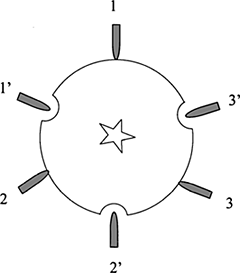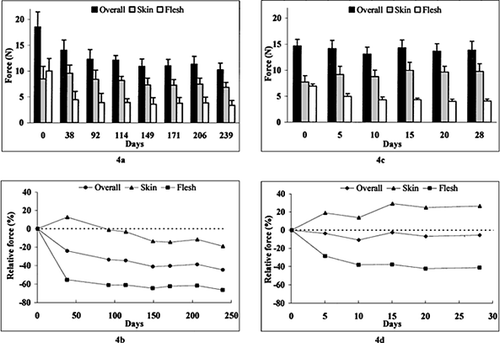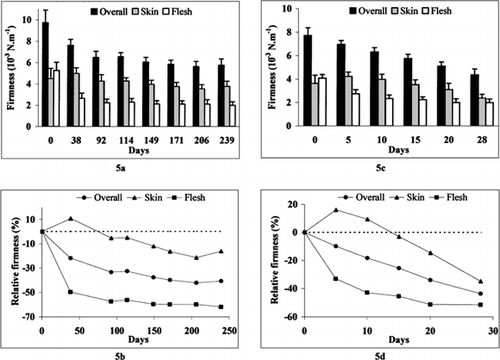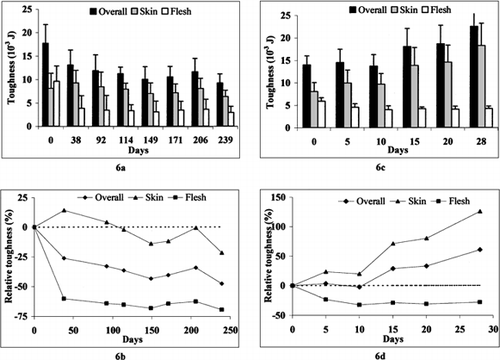Abstract
Usual puncture tests were applied to study texture properties (deformation, failure load, firmness, and toughness) of apple skin and apple flesh. The difference between overall puncture load displacement (whole fruit) and that measured without skin provided a satisfactorily precise result related to mechanical behavior of the skin itself. This procedure is applied to evaluate changes in skin and flesh properties of Golden Delicious apples, both during cold storage (2°C, 96% relative humidity) and ripening at constant room temperature (20 ± 1°C). Highest decreases occur in deformation (10%), firmness (50%), and toughness (60%) of the apple flesh early during the cool storage. Concurrently, the highest increases are related to the contribution of the skin to the overall firmness (43%) and to the overall toughness (15%). During forced ripening, the skin plays a great part in the relative changes in all the measured overall properties. Storage conditions (relative humidity and temperature) affect highly the percent contribution of the skin to the overall firmness. Additional experiments are carried out after a 210 days cool storage on four apple varieties (Fuji, Golden Delicious, Granny Smith, Pink Lady) to compare their mechanical behaviors. Differences in overall and skin toughness were found between varieties. Percent contribution of the skin to firmness value is alike for all apple varieties tested after a 210 days storage at 2°C. The contribution of the skin in the overall firmness is not a variety feature.
INTRODUCTION
After harvest, fruit and vegetable tissues are submitted to a lot of mechanical strains (shocks, vibrations, compressions) causing tissue damage and quality loss. Cell firmness and cell turgidity affect bruise susceptibility of many fruits and vegetables (Garcia et al., 1995; Steudle and Wieneke, 1985; Tong et al., 1999). High cell turgor pressure or high stress causes cell wall failure and weakens the gross tissue mechanical properties (Lin and Pitt, 1986). Highly turgid fruits are more bruise-susceptible than those with lower turgor (Samin and Banks, 1993; Johnson and Dover, 1990; Yuwana, 1997). During fruit ripening, firmness loss results at once from an integrity loss of cell wall components and from cell turgor changes. Skin maintains overall shape and integrity of many fruits and vegetables. It provides a physical barrier to microbial invasion. The mechanical behavior of the skin greatly influences firmness and resistance to splitting of fruit (Blahovec et al., 1995; Clevenger and Hamann, 1968; Lustig and Bernstein, 1985; Jackman and Stanley, 1994). A better knowledge of its physical properties is, as a matter of fact, of importance to select new varieties with lower bruise susceptibility.
Conventionally, puncture tests are carried out on a peeled area at the equator (ASAE, 1995; Bourne, 1965; Timbers et al., 1965). Various devices are used for this purpose (Abbott, 1999; Planton, 1996). Hand-operated instruments or semiautomatic devices take out only maximal force required for tissue breaking. Supplied results are solely related to the flesh firmness. Automatic apparatus with indenter movement control allow defined and constant speed of penetration. Mostly computerized, these systems have the ability to instantaneously record load displacement curve.
Several researchers (Lustig and Bernstein, 1985; Duprat et al., 2000; Jackman and Stanley, 1994; Thompson et al., 1992; Voisey et al., 1970) had shown the feasibility of usual puncture tests to study mechanical properties of fruit skin (apple, cucumber, grape berry, tomato). With tomato fruit ripening, Jackman and Stanley (1992) had noted an increase in effective area of compression during puncture with skin. From this they conclude nevertheless that the difference between overall puncture load displacement and that measured with the skin removed, can provide a first approximation of the load displacement behavior of the skin itself. Previous results of texture measurements on the Golden Delicious apple (Duprat et al., 2000) also suggested that error lies within the accuracy limits of the method and within the inter- and intralot variabilities.
This procedure is applied to texture property (deformation, failure load, firmness, and toughness) evaluation of apple skin and apple flesh, both during cold storage (2°C, 96% relative humidity) and ripening at constant room temperature (20 ± 1°C). To compare skin mechanical behavior, additional experiments are carried out after 210 days cool storage on four apple varieties (Fuji, Golden Delicious, Granny Smith, Pink Lady).
MATERIALS AND METHODS
Apple Samples
Measurements were made on lots of at least 20 apples approximately 70 to 80 mm. All lots were issued both from different harvests (1994, 1997, 1998) and various varieties: Fuji, Golden Delicious, Granny Smith and Pink Lady. Golden Delicious apples were hand-harvested in an experimental orchard at INRA (Montfavet, France) on August 30, 1994 and September 4, 1997. Immediately after each harvest, a sorting machine graded defect-free fruit, before placing them in cool storage at 2°C and 96% relative humidity during 239-day period. To achieve a wide range of maturity degree, a sample of 120 apples was randomly selected after 28 days cool storage. Before experiment, the fruits were maintained at constant temperature (20 ± 1°C) in a ventilated storage room for forced ripening. At fixed intervals (0, 5, 10, 15, 20, and 28 days), a lot of 20 fruits were measured for their mechanical properties.
Fruits supplied by Société des vergers Alpilles-Lubéron (Lamanon, South of France) and harvested in 1998 were used to mechanical properties comparison. For this experiment, four varieties (Fuji, Golden Delicious, Granny Smith, Pink Lady) the same size (70 mm) were tested after 210 days cool storage.
Puncture Test
Firmness measurements were performed using a firmness tester controlled and programmed using an internal PC card (Duprat et al., 1995). After removing from the cool store, apples were kept during 24 h at 20°C before testing. A cylindrical indenter, 4 mm in diameter, with a hemispherical tip was used. A computer-driven stepping motor moves the indenter at a constant speed of 20 cm.min−1. Each step corresponds to an advance of 10 μm. This device had a precision of 10 μm in displacement and 0.01 N in force. The loading force at each 10 μm displacement step was sampled and saved on the hard drive of a computer.
Measurements were taken in the equatorial region of the whole fruit (Fig. ), up to 10 mm flesh depth. Penetration test on each apple was first carried out at three equally distributed locations (1, 2, 3) on the equator for load displacement curve with skin. Next, the puncture test was performed for load displacement curves at peeled locations (1′, 2′, 3′) between the measured points (Chen et al., 1996). To standardize the paring thickness (2 mm), peeling was done with a potato peeler.
Load Displacement Curve
Load displacement curves obtained with and without skin include 1000 load values (Fig. ). The output from a whole apple at constant strain rate (broad line) presents a linear compression part (a) with a maximum (Ft). After this, the load falls to a lower level (b) as the indenter moves through the tissue. The effect of friction on the sides of the indenter may have been the primary cause of the slight rise in force for additional displacement. The first and largest peak (Ft) representing skin bursting, occurs when the flesh elasticity limit is reached and then the flesh collapses.
Figure 2. Load-displacement curve from puncture tests. Ft, bursting skin force; Fd, force corresponding to the elasticity limit of the flesh; Dp, displacement related to Ft; Dc, displacement related to Fd.

Without skin (sharp line), peak is missing. Maximum level of the linear compression part (a′) represents the flesh elasticity limit. Its value is almost equal to the mean force value of the shear force phase (b′). Thereafter, the loading force increases slightly.
Inferred parameters from load displacement curves with skin, are bursting skin force Ft and related displacement Dp. Without skin, inferred parameters are maximum load Fd of the linear compression phase (a′) and related displacement Dc. Fd corresponds to the elasticity limit of the flesh.
Contribution of the Skin to Firmness Values
Curve parts related to puncture shear with whole fruit (b) and with skin removed (b′) are virtually parallel unless superimposed. Therefore, the contribution of the skin (Fp) to the overall bursting force is equal to the difference between the overall rupture force (Ft) and the flesh rupture force (Fd):
Displacements
On principle, puncture tests supply a pinpoint measure of firmness. So as to limit the effect of the fruit heterogeneity on the data (Anzaldua-Morales et al., 1992; Duprat et al., 1991; Jackman and Stanley, 1992), comparison is made between each displacement value with whole fruit and those measured without skin at 1 close locations:
-
.1 with 1′ and 3′
-
.2 with 1′ and 2′
-
.3 with 2′ and 3′.
The three pairs of data retained for comparisons are those ones where absolute error on the displacement is lowest: error = |Dp − Dc|. Selected individual measurements taken at three locations with and without skin are averaged to describe firmness properties of individual fruit.
Firmness Parameter
Puncture firmness in N.m −1 is calculated as the average slope of load- displacement curve from zero to the point of rupture or failure (Finney, 1969). For apples, this curved part is generally straightforward. Therefore, the curve slope will be calculated from both the puncture force (Ft or Fd and the displacement (Dp or Dc) induced by this force:
Toughness (rigidity), or mechanical energy or work required for skin rupture is calculated from the area under load displacement curves from zero up to the point of rupture or failure (Finney, 1969). So, toughness will be determined as follow:
RESULTS AND DISCUSSION
Displacements
For Golden Delicious at harvest, displacements Dp and Dc, respectively, measured with and without skin are alike (Fig. a). For all varieties after storage, displacement Dp is always higher than Dc. During the first month of cool storage of Golden Delicious (Fig. b), flesh deformation Dc decreases 10%: this variation is statistically significant (P = .05). During the same period, overall deformation Dp does not vary significantly (Fig. b) but the percent contribution of the skin to the overall deformation rises 5%. During a 239-day cool storage, subsequent variations of deformation with and without skin are not significant: difference between these deformation remains constant at ca. 8% (Fig. b). The greatest decrease in bruise susceptibility (Garcia et al., 1995; Klein, 1987) and in flesh deformation (Dc) largely occurs during the initial cool storage period. These variations are consistent with the loss in cell turgor potential over time during storage.
Figure 3. The puncture displacement and relative displacement of Golden Delicious apples during storage. a) and b) cool storage at 2°C and 96% relative humidity during 239 days. c) and d) forced ripening at 20 ± 1°C during 28 days. Error bars represent standard deviation of means for at least 20 apples.
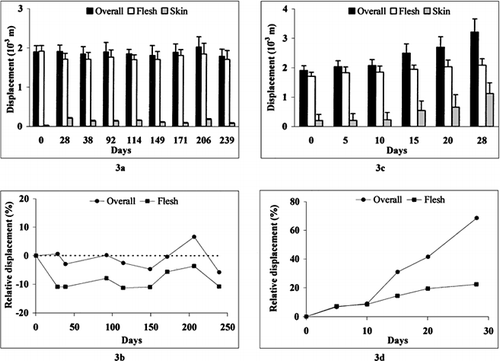
During 28 days of forced ripening in a storage room maintained at 20 ±1°C, deformations Dp and Dc increase respectively by 69 and 23% up (Fig. c). During the first 10 days, both deformations have the same rate of increase (Fig. d). Subsequent rate of overall deformation increase is about four times higher than that of the flesh deformation.
Garcia et al. (1995) found a relationship between weight loss and deformation at skin puncture with Golden Delicious apples ripening for 8 days at room temperature. They concluded that deformation at skin bursting is related to the fruit water status: high turgidity is related to lower deformation and to higher bruise susceptibility. In comparable conditions of forced ripening (ventilated storage room with thermostatic control at 20°C, and without humidity control) with apples previously cool stored during 28 days, overall deformation Dp is strongly dependent of the skin. In this case, increase of the overall deformation results less from a turgidity loss of the flesh than from a drying up of the skin and/or the underlying pericarp tissue.
Maximum Force of Compression
For Golden Delicious at harvest, flesh rupture force (Fd) is higher than skin rupture force (Ft-Fd). Skin represents 46% of the overall rupture force (Ft). Overall, rupture force decreases 44% during a 239-day cool storage at 2°C (Fig. a), but does not significantly vary (P = .05) during a 28-day of forced ripening at 20°C (Fig. c). Concurrently, flesh rupture force decreases respectively by 66% and 42%. Greatest decreases occur during initial storage (55% in 1 month at 2°C, 28% in 5 days at 20°C) and are associated with an increase of the skin rupture force. Study of percent variation of the rupture force points out a main influence of the skin on all further variation during storage (Figs. b and d). At the end of the storage period, relative contribution of the skin accounts for 65% to 70% of the force required to puncture fruit. These results have the same magnitude as those obtained by Thompson et al. (1992) from preliminary punch test with various fruits (avocado, Bartlett pear, McIntosh apple) and vegetables (eggplant, green bell pepper, slicing- type cucumber, zucchini squash): relative contribution from 58% to 88% of the overall puncture force.
Firmness
For Golden Delicious at harvest, flesh firmness (Ft/Dp) is higher than skin firmness (Ft/Dp-Fd/Dc). Skin accounts for about 45% of the overall firmness of whole apples: a fast and significant increase in this contribution occurs early during storage (Figs. a and c). Overall firmness (Ft/Dp) decreases to 41% during a 239-day cool storage at 2°C (Fig. b) and to 44% during a 28-day forced ripening at 20°C (Fig. d). Concurrently, flesh firmness respectively decreases by 62% and 51%. After a month cool storage or a 5-day forced ripening, skin firmness (Ft/Dp-Fd/Dc) accounts for 65% of the overall firmness of apples stored at 2°C and for more than 60% of those maintained at 20°C. Afterwards, no change occurs. Subsequent changes in overall firmness result mainly from firmness loss of the skin. Similar results were obtained previously (Jackman and Stanley, 1992; Voisey et al., 1970) with tomato during ripening. The contribution of the skin to the overall firmness is thus not typical of the maturity degree but appears related to the storage conditions. Indeed, highest percent contribution of the skin is reached faster when storage temperature is higher.
Toughness
For Golden Delicious at harvest, skin toughness (Ft.Dp/2-Fd.Dc/2) is smaller than flesh toughness, and accounts for 45% in the overall toughness (Ft.Dp/2). During a 239-day cool storage, decreases in overall toughness and flesh toughness are respectively 48% and 70% (Fig. a). Significant increase (14%) of the skin toughness occurs during the first month of cool storage, and then evolves together with the overall toughness (Fig. b). Past a month cool storage, flesh toughness accounts no more than 40% of its value at harvest, and then decreases only a few. At this time, percent contribution of the skin to the overall toughness is about 70%, and this percentage remained unchanged until the end of the storage period. During a 28-day forced ripening period at 20°C (Fig. c), skin toughness and overall toughness rise continuously, respectively, by 102% and 46%. During the same period, flesh toughness diminishes linearly, but to a lesser extent (29%). Differences of percent change of the toughness are related to storage conditions (Fig. b and d). During the first month of cool storage (Fig. b), relative decreases in flesh toughness and in overall toughness are joined together with a relative increase in skin toughness. Afterwards, change in the overall toughness results only from a decrease of the skin toughness. During a 10-day ripening at 20°C, no change occurs with the overall toughness because other toughness varies in the same ratio but in the opposite direction: increasing in skin toughness and decreasing in flesh toughness. Further increase of the skin toughness plays a great part in the relative change of the overall toughness. After a 28-day period, skin toughness accounts for 81% of the work required for skin bursting. For tomato, Jackman et al. (1992) found an increase of the skin toughness during storage. This increase should result from withering of the skin and/or the underlying pericarp tissue (Wilkinson, 1965) leading to higher work required to skin puncture.
Effect of Variety on the Physical Properties of the Skin
Four apple varieties (Fuji, Granny Smith, Golden Delicious, Pink Lady) were tested after a 210-day cool storage (Figs. a to d). Statistical analysis (ANOVA: P = .05) indicated significant differences for overall deformation (Dp), skin deformation (Dp-Dc), and rupture force with (Ft) and without skin (Fd). Differences between Fuji and Granny Smith are not significant for the overall firmness (Ft/Dp), flesh firmness (Fd/Dc), and skin firmness (Fp/Dp − Fd/Dc). In the same way, Fuji and Pink Lady do not differ from flesh toughness (Fd.Dc/2) and skin toughness (Ft.Dp/2 − Fd.Dc/2). Granny Smith shows significant differences in overall toughness (Ft.Dp/2) with respect to other varieties.
Figure 7. Firmness properties of four apples varieties (Fuji, Granny Smith, Golden Delicious, Pink Lady) after a 210-day cool storage period. a) displacement; b); rupture force; c) firmness; d); toughness. Error bars represents standard deviation of means for 20 apples.
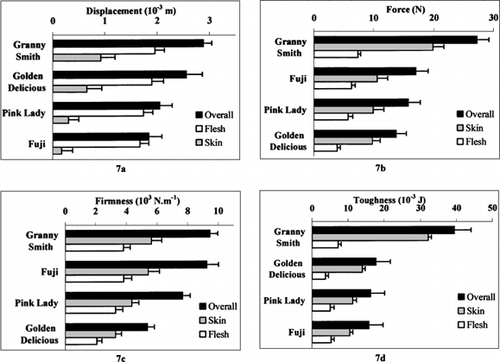
Contributions of the skin to the firmness properties measured with whole fruit are summarized in Table . Significant differences between varieties concern contribution to the overall deformation, the overall rupture force, and the overall toughness. Nevertheless, these differences are not related to the same varieties in accordance with physical property taken into account. Between varieties, contributions of the skin to the overall firmness are not significant although significant difference in overall firmness is found. For all the varieties, these contributions ranged from 57% to 61%. Thus, contribution of the skin in the overall firmness is not a variety feature.
Table 1. Contributions of the Skin to the Firmness Properties for Four Apple Varieties (Fuji, Granny Smith, Golden Delicious, Pink Lady), Tested After a 210-Day Storage at 2°C. Mean ± Standard Deviation
CONCLUSION
Puncture tests through skin enable simultaneous measurements of fruit flesh and skin firmness. The punch method may be applicable to determine physical status (turgidity, withering) of the skin and underlying pericarp cells affecting bruise susceptibility. Differences between whole fruit load displacement curve and that measured with the skin removed provide knowledge on the mechanical behaviors of the skin itself. During the initial period of cool storage, we noted the highest decrease in deformation (10%), firmness (50%), and toughness (60%) of the apple flesh as well as the highest increase of percent contribution of the skin to the overall firmness (43%) and to the overall toughness (15%). These changes result mainly from turgidity loss of the flesh. At the same time the overall displacement does not significantly vary. During forced ripening, the skin plays a great part in the relative changes of the overall displacement, the overall firmness, and the overall toughness. Our results point out a main effect of the storage conditions (relative humidity and temperature) on the percent contribution of the skin to the overall firmness. Percent contribution of the skin to firmness value is alike for all apple varieties tested after a 210-day storage at 2°C. The contribution of the skin in the overall firmness is not a variety feature On the other hand, differences in overall (Ft.Dp/2) and skin (Ft.Dp/2 − Fd.Dc/2) toughness were found between varieties.
Acknowledgments
REFERENCES
- Abbott , J. A. 1999 . Quality Measurement of Fruits and Vegetables . Postharvest Bio. Technol. , 15 ( 3 ) : 207 – 225 .
- Anzaldua-Morales , A. , Bourne , M. C. and Shomer , I. 1992 . Cultivar, Specific Gravity and Location in Tuber Affect Puncture Force of Raw Potatoes . J. Food Sci. , 57 : 1553 – 1536 .
- 1995 . “ ASAE. ASAE Standard: ASAE S368.3. Compression Test of Food Materials of Convex Shape ” . In Standards Engineering Practice and Data Adopted by the ASAE 466 – 470 . St. Joseph, MI : ASAE .
- Blahovec , J. , Jeschke , J. and Houska , M. 1995 . Mechanical Properties of the Flesh of Sweet and Sour Cherries . J. Texture Stud. , 26 : 45 – 57 .
- Bourne , M. C. 1965 . Studies on Punch Testing of Apples . Food Technol. , 19 : 413 – 415 .
- Chen , H. , Duprat , F. , Grotte , M. , Loonis , D. and Piétri , E. 1996 . Relation of the Impact Transmission Wave to the Apple Texture During Ripening . J. Texture Stud. , 27 : 123 – 141 .
- Clevenger , J. T. and Hamann , D. D. 1968 . The Behavior of Apple Skin under Tensile Loading . Trans. ASAE , 11 : 34 – 37 .
- Duprat , F. , Grotte , M. , Loonis , D. and Piétri , E. 2000 . Etude de la Possibilité de Mesurer Simultanément la Fermeté de la Chair et de L'épiderme des Pommes . Sci. Aliments , 20 ( 2 ) : 253 – 264 .
- Duprat , F. , Piétri , E. , Grotte , M. G. and Studman , C. J. 1995 . A Multi-purpose Firmness Tester for Fruits and Vegetables . J. Comput. Electron. Agric. , 12 : 211 – 223 . 1995
- Duprat , F. , Roudot , F. , Grotte-Nicolas , M. and Roudot , A. C. 1991 . De L'hétérogénéité des Fruits . Sci. Aliments , 11 : 609 – 622 .
- Finney , E. E. 1969 . To Define Texture in Fruits and Vegetables . Agric. Eng. , 50 : 462 – 465 .
- Garcia , J. L. , Ruiz-Altisent , M. and Barreiro , P. 1995 . Factors Influencing Mechanical Properties and Bruise Susceptibility of Apples and Pears . J. Agric. Eng. Res. , 61 : 11 – 18 .
- Jackman , R. L. and Stanley , D. W. 1992 . Area- and Perimeter-Dependent Properties and Failure of Mature-Green and Red-Ripe Tomato Pericarp Tissue . J. Texture Stud. , 23 : 461 – 474 .
- Jackman , R. L. and Stanley , D. W. 1994 . Influence of the Skin on Puncture Properties of Chilled and Nonchilled Tomato Fruit . J. Texture Stud. , 25 : 221 – 230 .
- Johnson , D. S. and Dover , C. J. 1990 . Factors Influencing the Bruise Susceptibility of Bramley's Seedling Apples . Proceedings of the European Workshop on Impact Damage of Fruits and Vegetables, Vol. 2, 22nd International Conference on Agricultural Mechanization . 1990 , Zaragoza, Spain. pp. 89 – 94 .
- Klein , J. D. 1987 . Relationship of Harvest Date, Storage Conditions, and Fruit Characteristics to Bruise Susceptibility of Apple . J. Am. Soc. Hortic. Sci. , 112 : 113 – 118 .
- Lin , T. T. and Pitt , R. E. 1986 . Rheology of Apple and Potato Tissue as Affected by Cell Turgor Pressure . J. Texture Stud. , 17 : 291 – 313 .
- Lustig , I. and Bernstein , Z. 1985 . Determination of the Mechanical Properties of the Grape Berry Skin by Hydraulic Measurements . Sci. Hortic. , 25 : 279 – 285 .
- Planton , G. 1996 . Mesurer la Qualité des Fruits. Méthodes et Appareils Nécessaires . Infos CTIFL , 124 : 22 – 26 .
- Samim , W. and Banks , N. H. 1993 . Effect of Fruit Water Status on Bruise Susceptibility and Bruise Colour of Apple . N. Z. J. Crop Hortic. Sci. , 21 : 373 – 376 .
- Steudle , E. and Wieneke , J. 1985 . Changes in Water Relations and Elastic Properties of Apple Fruit Cells During Growth and Development . J. Am. Soc. Hortic. Sci. , 110 : 824 – 829 .
- Thompson , R. L. , Fleming , H. P. and Hamann , D. D. 1992 . Delineation of Puncture Forces for Exocarp and Mesocarp Tissues in Cucumber Fruit . J. Texture Stud. , 23 : 169 – 184 .
- Timbers , G. E. , Staley , L. M. and Watson , E. L. 1965 . Determining Modulus of Elasticity in Agricultural Products by Loaded Plungers . Agric. Eng. , 46 : 274 – 275 .
- Tong , C. , Krueger , D. , Bedford , D. , Luby , J. , El-Siekh , A. , Shackel , K. and Ahmadi , H. 1999 . Comparison of Softening-Related Changes during Storage of ‘Honeycrisp’ Apple, Its Parents, and ‘Delicious’ . J. Am. Soc. Hortic. Sci. , 124 : 407 – 415 .
- Voisey , P. W. , Lyall , L. H. and Kloek , M. 1970 . Tomato Skin Strength—Its Measurement and Relation to Cracking . J. Am. Soc. Hortic. Sci. , 95 : 485 – 488 .
- Wilkinson , B. G. 1965 . Some Effects of Storage under Different Conditions of Humidity on the Physical Properties of Apples . J. Hortic. Sci. , 40 : 58 – 65 .
- Yuwana . 1997 . “ Contribution à l'étude des Propriétés de Résistance Mécanique des Fruits (de la Pomme Golden Delicious) ” . In Thèse Docteur (Spécialité : Mécanique des solides) 89 France : Université de la Méditerranée: Aix-Marseille II . N°3401.97.153
